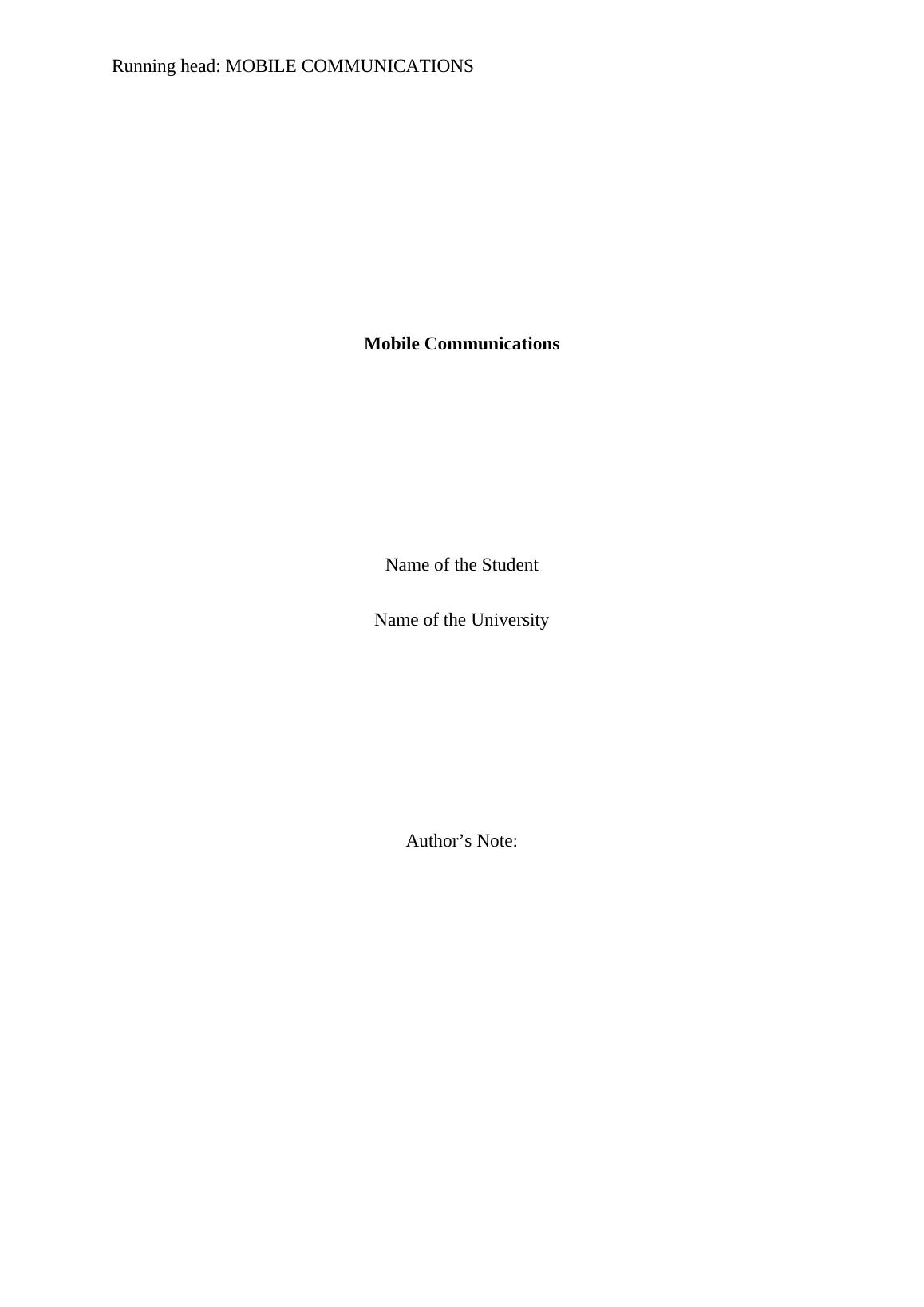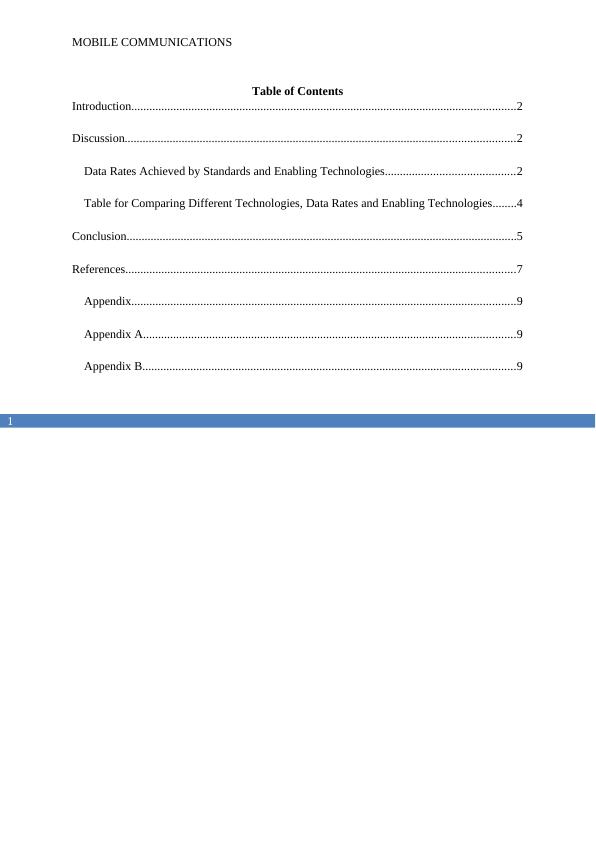Digital Signal Processing (EEC 4963)
Added on 2022-01-05
10 Pages1892 Words26 Views
Running head: MOBILE COMMUNICATIONS
Mobile Communications
Name of the Student
Name of the University
Author’s Note:
Mobile Communications
Name of the Student
Name of the University
Author’s Note:

1
MOBILE COMMUNICATIONS
Table of Contents
Introduction................................................................................................................................2
Discussion..................................................................................................................................2
Data Rates Achieved by Standards and Enabling Technologies...........................................2
Table for Comparing Different Technologies, Data Rates and Enabling Technologies........4
Conclusion..................................................................................................................................5
References..................................................................................................................................7
Appendix................................................................................................................................9
Appendix A............................................................................................................................9
Appendix B............................................................................................................................9
MOBILE COMMUNICATIONS
Table of Contents
Introduction................................................................................................................................2
Discussion..................................................................................................................................2
Data Rates Achieved by Standards and Enabling Technologies...........................................2
Table for Comparing Different Technologies, Data Rates and Enabling Technologies........4
Conclusion..................................................................................................................................5
References..................................................................................................................................7
Appendix................................................................................................................................9
Appendix A............................................................................................................................9
Appendix B............................................................................................................................9

2
MOBILE COMMUNICATIONS
Introduction
Data transmission can be stated as the procedure to send the digital as well as analog
data on the communication medium with one and more communication device, networking,
computing and electronic device (Oshima et al. 2016). This data transmission even helps in
enabling the proper transfer or even communication of the devices within the environment of
multipoint to multipoint, point to multipoint and point to point. The data transmission is
termed as the digital communication or digital transmission. It is also reserved for both
sending and receiving of digital data and has the intention of sending the data object and file
for one and more recipient devices (Lu, Li and Guizani 2014). The following report outlines a
brief discussion on the evolution of data transmission over the mobile networks from 2G to
4G and LTE.
Discussion
Data Rates Achieved by Standards and Enabling Technologies
There are several standards of data transmission like RS232, RS42q2, RS423 and
RS485. These are widely utilized for some of the major data links that provide connectivity to
the users (Zhang et al. 2013). Although, these data transmission link with the used cables, a
variety of several functions are present for enabling the data that is to be sent reliably within
two specified equipment. There is a number of several wires that were being utilized in the
cable, while sending parallel data. RS or recommended standard is the equivalent standard
that is written for the ITU for providing more international standard. It enabled the same
standards that were used world wide and giving access to the users. This particular standard
was also known as version 24 and was completely compatible with the RS 232. The
requirement of the fast communication was responsible for introducing the several standards
of communication (Koenig et al. 2013). Each of these standards of mobile communication
MOBILE COMMUNICATIONS
Introduction
Data transmission can be stated as the procedure to send the digital as well as analog
data on the communication medium with one and more communication device, networking,
computing and electronic device (Oshima et al. 2016). This data transmission even helps in
enabling the proper transfer or even communication of the devices within the environment of
multipoint to multipoint, point to multipoint and point to point. The data transmission is
termed as the digital communication or digital transmission. It is also reserved for both
sending and receiving of digital data and has the intention of sending the data object and file
for one and more recipient devices (Lu, Li and Guizani 2014). The following report outlines a
brief discussion on the evolution of data transmission over the mobile networks from 2G to
4G and LTE.
Discussion
Data Rates Achieved by Standards and Enabling Technologies
There are several standards of data transmission like RS232, RS42q2, RS423 and
RS485. These are widely utilized for some of the major data links that provide connectivity to
the users (Zhang et al. 2013). Although, these data transmission link with the used cables, a
variety of several functions are present for enabling the data that is to be sent reliably within
two specified equipment. There is a number of several wires that were being utilized in the
cable, while sending parallel data. RS or recommended standard is the equivalent standard
that is written for the ITU for providing more international standard. It enabled the same
standards that were used world wide and giving access to the users. This particular standard
was also known as version 24 and was completely compatible with the RS 232. The
requirement of the fast communication was responsible for introducing the several standards
of communication (Koenig et al. 2013). Each of these standards of mobile communication

End of preview
Want to access all the pages? Upload your documents or become a member.
Related Documents
5G mobile technology Paper 2022lg...
|6
|5536
|16
Review of RS232 Ports and RobotServer.c Programlg...
|9
|2685
|127
The Advent of 4G Telecommunication Assignmentlg...
|9
|1565
|95
Wireless And Network Security Assignment 2022lg...
|10
|2527
|22
How 2G NETWORK WORKS?lg...
|7
|2201
|386
Assignment On How 2G Network Workslg...
|10
|2763
|148
